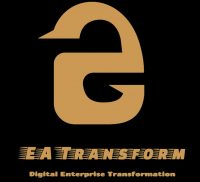What is EA Transform?
EA Transform is an initiative created by Mr. Arsalan Rad and Mr. Simon Howden to Provide a license-free and freely accessible unified method and framework called “ePerspectives” for Enterprise Digital Transformation based on sound Enterprise Architecture; this method and framework is called “ePerspectives”.
Unlike most other frameworks, ePerspectives is INTUITIVE, UNDERTSANDABLE, SIMPLIFIED, UNIFIED, PRACTICAL AND PRAGMATIC, and can actually provide very specific practical how-to-do guide to “getting things done in practice”, as opposed to “impressive in theory, but not for doing and getting results”
ePerspectives has already been used to deliver unprecedented success and RESULTS at global household brands and leading organizations at highest strategic and visibility level leading to excellent feedback and review from C-Level executives to practitioners, from Enterprise and Business Architects, IT and Solution Architects, Program Managers to developers (please refer to the Testimonials section).
E-Perspectives is a strongly EA-driven framework and method developed by Mr. Arsalan Rad that provides a simplified, practical, and pragmatic approach to Enterprise Digital Transformation. e-Perspectives brings the best of established EA methods and framework such a TOGAF, Zachman, DODAF, and leverages them in a distillable and practical manner, that can not only be much more easily understood, but implemented.
Why ePerspectives, and not TOGAF?
Some great question to ask when discussing or promoting the more “academic” Enterprise Architecture frameworks such as TOGAF is:
- Have there been actual Enterprise Digital Transformation engagements that have produced TARGETED VALUE FOR THE BUSINESS? Lamentably, the answer to this question is regularly “No”!
- Does TOGAF provide an established unified baseline and language across different perspectives of an enterprise, e.g. Business Strategy, Operations, Sales, Delivery, Technology, …?
- Is TOGAF distillable and understood by other roles than architects?
- Is TOGAF focus largely the entire holistic enterprise, or, largely IT?
TOGAF provides greatly useful “thoughts” and theory for Enterprise Architecture, but is often used as an academic platform for architects and technical staff to discuss “the science of Enterprise Architecture”, rather than a focus on” producing Business Results”.
In fact the Open Group itself acknowledges that TOGAF needs to be customized to be made practical and fit-for-purpose.
In other words, TOGAF is more theoretical, expressed in Academic language mostly distillable for Architects (if they succeed), and its scope is largely “Enterprise IT Architecture”. Although TOGAF has some mention or coverage of areas such as Vision, Strategy, Business Architecture, and Governance, these key perspectives are often seen from the “Point of view of IT and Architecture”; this can be clearly observed when looking at the “Left side” of the TOGAF ADM Diagram, where areas such as Governance are largely covered with focus and direct relation to Enterprise (IT) Architecture.
Please refer to the presentation “ePerspectives vs TOGAF” on the EA Transform site to establish a close and detailed view of the differences between the 2 frameworks.
ePerspectives History & Background
ePerspectives was progressively created by Mr. Arsalan Rad during 25 years of working in the forefront of Enterprise Transformation leveraging Enterprise Architecture in pioneering engagements for industry leaders such as Accenture, IBM, and DXC, and world leading clients such as Philips, ING Bank, NHS UK, KPN, AXA, TESCO, …
Having led many highly challenging and complex strategic transformation engagements to success, Mr. Rad developed a strong belief that academic and purely IT-science based methods and frameworks are tedious, scarcely distillable, not unified and unifying (across business and IT), and do not provide a practical guide for enterprise transformation. This was witnessed in many leading organizations who enthusiastically adopted frameworks like TOGAF (or even PM Frameworks like Prince 2) to facilitate governance, communication, unification, and achieving RESULTS, but saw the opposite impact, i.e. a loss of faith in methodology, after failed attempts or scarcity of achieved results.
In 2020, Mr. Simon Howden joined the EA Transform initiative as a partner as well as key contributor to further developing ePerspectives.
Mr. Howden is a prominent Enterprise Architect and Digital Transformation expert with 25 + years experience at the forefront of enterprise architecture and transformation, a close former colleague and friend.
Mr. Rad and Mr. Howden share the same vision and aspiration that there is a strong imperative to have a method and framework that was largely spoken in “Human or Business” terminology, and not tedious technical terminology, and would truly serve and encourage and people involved in complex projects, instead of the opposite effect due to tediousness or impracticality of use or understanding.
We are not here to impress, we are here to guide the business to achieve results! The business should not learn to speak or understand the language and ways of Architects or IT, this should be the other way around!
As a result, ePerspectives has been created and devised as a freely available method and framework, which goes through lengths to speak in more simple human-distilled language and terminology, is highly intuitive with reliance on analogies with other established human sciences.
ePerspectives looks at an enterprise from the point of view of various “Perspectives” , rather than through an Architect’s lenses, and separates every perspective’s internals (what is irrelevant to other perspectives) from Externals (what is relevant to other perspectives), and thus provides a Unified, Simplified, Understandable, Manageable, Intuitive framework and method to make it possible to successfully achieve a Digital Enterprise through (EA-Driven) Digital Transformation.
The framework was IP’ed in 2006, and has since then been customized and successfully used and deployed in leading organizations, with excellent results and praise from prominent global executives (please refer to Testimonials section).
ePerspective Key Advantages
Business-driven framework – approach and tool in a box:
Transform and future-proof your business and IT with our all-encompassing highly practical digital transformation framework implemented in a world leading enterprise transformation tool
Unified baseline – harmonized goals and direction:
Simplify, standardize, and baseline enterprise landscape as a harmonized ecosystem of components, ensuring that different organizational entities are not silo’ed or consumed with own agenda, but work in synch with goals and objectives unified and aligned to those of the business
Unified view – fact and RoI based decision making:
Report, monitor and visualize your organization in a single unified dashboard, thereby enabling fact and RoI based assessment and transformation planning to ensure various initiatives across business and IT are justified in cost and purpose
Legacy IT cost savings – self-finance your innovation:
Accelerate your business innovation and time to market by identifying innovation initiatives and driving them as optimized and driven from tangible cost savings, and in tandem with your modernization – innovate while you modernize legacy!
ePerspective Key Characteristics
5 Key PERSPECTIVES OF “BECEO”: Business, Enterprise, Change, Enterprise Planning, Operations (Key focus here on BEC)
1-ONE UNIFIED ENTERPRISE BASELINE – UNIFIED LANGUAGE AND TERMINOLOGY
ePerspectives is a framework that can be applied to any organization as a UNIFIED BASELINE to clarify various functions and organizational entities and harmonizes them to better fulfil a collective and collaborative ENTERPRISE-LEVEL purpose. This is similar to using an ELECTRONIC CIRCUIT DIAGRAM for the enterprise, with various SELF CONTAINED COMPONENTS representing different functions and interactions across the enterprise enabling MODULAR design , and UNIFIED, SEQUENTIAL, TRACEABLE, END-TO-END view of the enterprise
2-MINIMISED NUMBER OF ARTEFACTS AND DOCUMENTS
ePerspectives only uses ONE CENTRAL ENTERPRISE ARTEFACT ! This is called X-CAPABILITY MODEL OR “XCM”, which serves as the “Enterprise Decision Making Dashboard” or “Command & Control Center”, that makes it possible to achieved unified global oversight, plan, control, and monitor optimally, and apply what-if scenarios and fact-based analysis for optimization and cost saving. XCM is similar in semantics, but different in characteristics, across the 3 Perspectives of Business (BCM), Enterprise (ECM), and Change (CCM). While every individual Perspective will have INTERNAL ARTEFACTS AND DOCUMENTS, these are only deemed of visibility relevance only to the individual Perspective in question. ALL key relevant aspects and artefacts across the organization can be accessed through using this baselined XCM. A ROLE-BASED ACCESS MODEL ensures that only data and artefacts that are pertinent to a given role/Perspective are made accessible accordingly.
3-SEPARATION OF CONCERNS (PERSPECTUVE ENCAPSULATION)
ePerspectives underlines the importance not mixing concepts across very different functions (perspectives) to avoid different and disjointed role-dependent organizational views and perceptions as well as terminologies that cannot be easily reconciled. Each PERSPECTIVE focuses only on A)Its own scope and area of concern and B)Its interactions and contracts to fulfill with respect to other organizational functions (Perspectives)
4-INTERNAL vs EXTERNAL
Having one Unified Enterprise Baseline makes it possible to achieve Separation of Concerns across the organization through dividing the scope and area of concern for each Perspective into 2 distinct categories:
- INTERNAL: What is only of direct relevance and interest to a given perspective, e.g. “Enterprise Architecture” or “Change Planning” but not directly relevant to other functions and entities in the organization (except to rely on their “agreed input/output” where applicable)
- EXTERNAL: Focus only on what is of relevance and interest to the orchestration and interaction between different Perspectives (departments, BU’s…) in order to best operationalise interactions with other functions and entities (Perspectives) in the organisations to optimise the flow, interaction, and mutual contract fulfilment
5-HIGH COHESION, LOW COUPLING
Breaking down the organization to separate self-contained and inter-dependent components that interact and collaborate based on clearly agreed “contracts” makes the organization highly cohesive, with components’ primary characteristics and functionality being only directly related and relevant to their Perspective, while Coupling is minimized as the number of critical interactions points is minimized, thus facilitating the planning and monitoring and control, and significantly increasing flexibility due to modularity.

